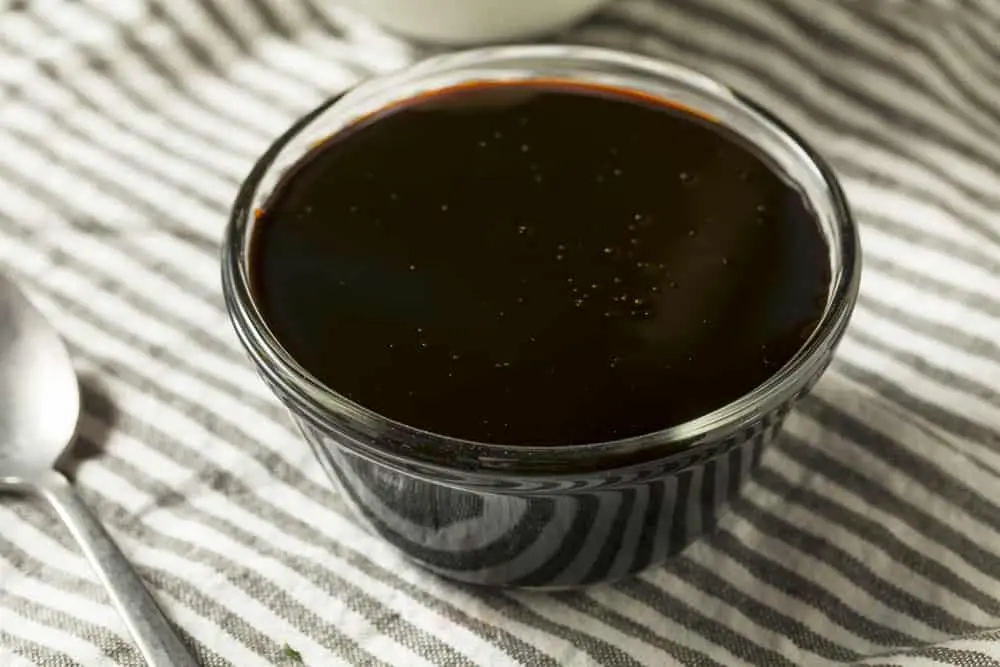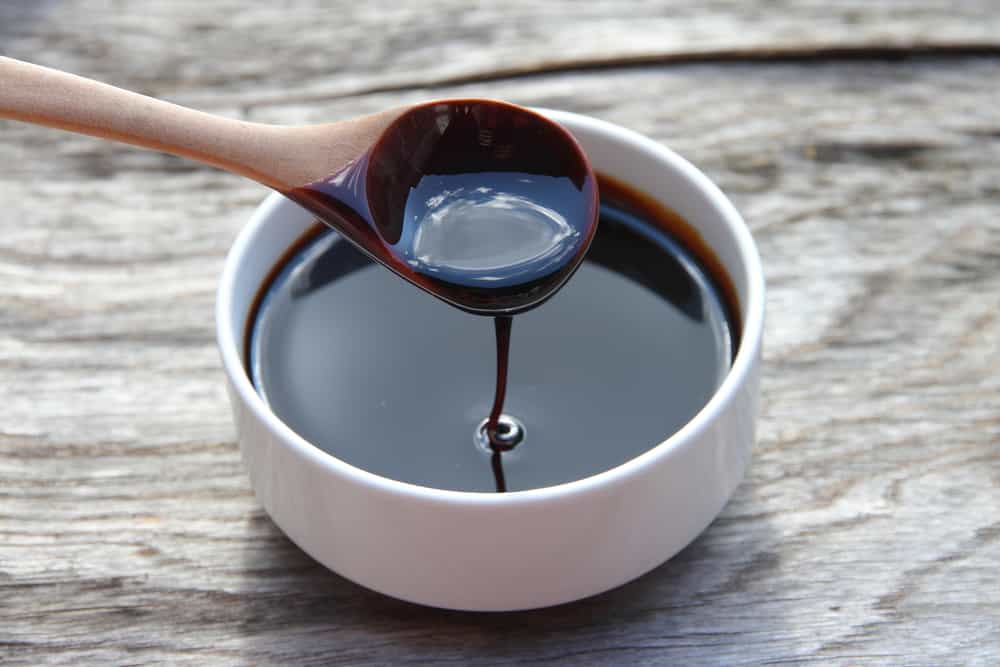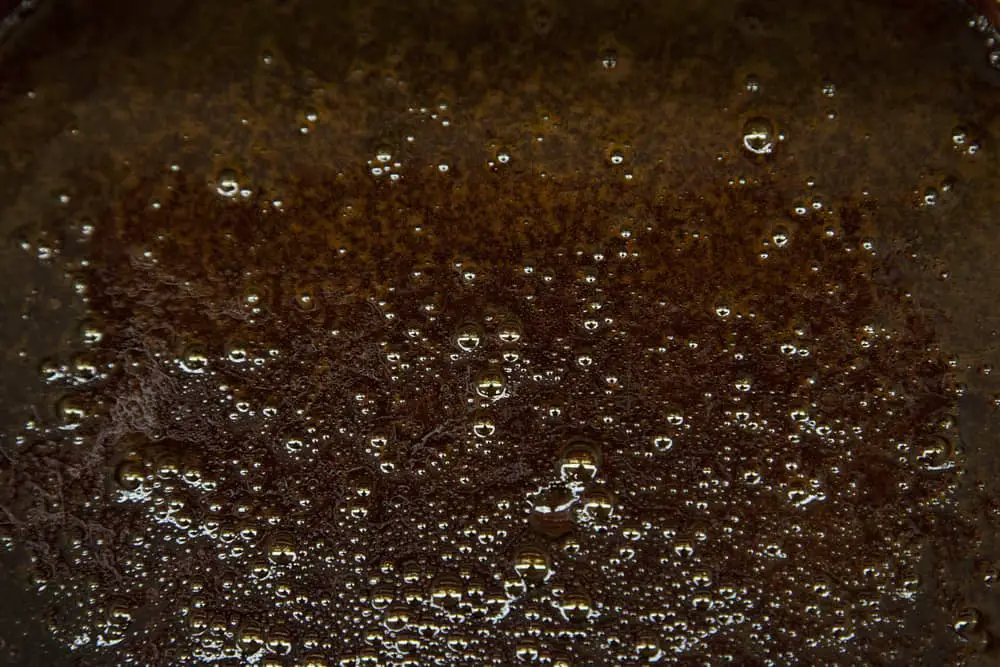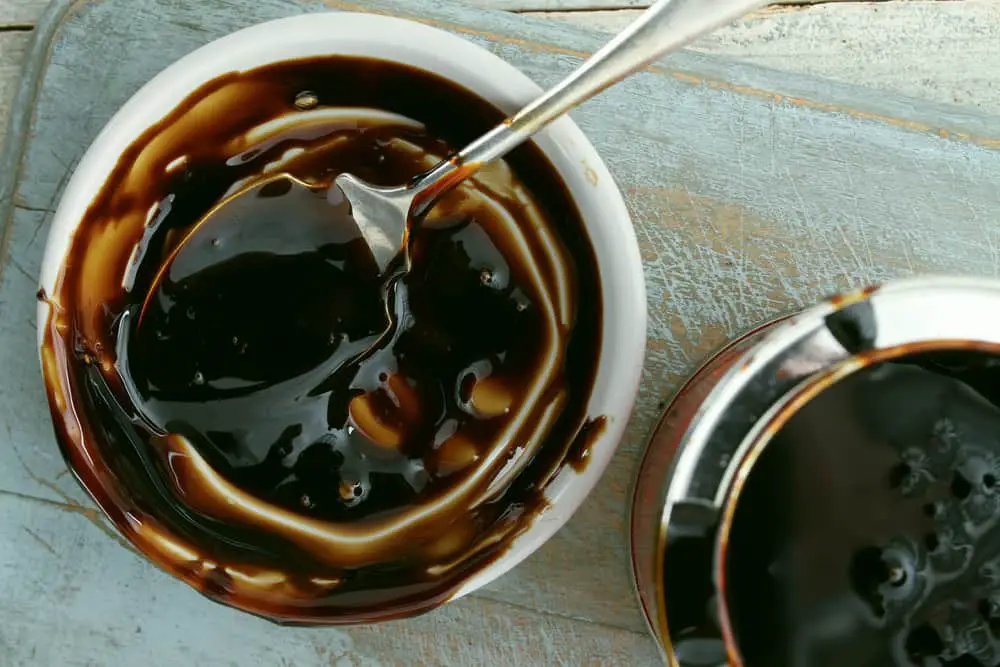Some sweets require a rustic and more autumn-like flavoring to bring out the boldness of the ingredients, and molasses certainly fits this ideal. This syrup can vary in flavor and intensity, so you need to understand the different types of the products in order to choose the right one for your recipe, whether you are baking a sweet treat or grilling a pork tenderloin outside. So what exactly is it?
This sweet stuff is a thick, dark syrup made during the sugar-making process. First, sugar cane or sugar beets are crushed, and the juice is extracted. The juice is then boiled down to form sugar crystals, which are removed from the liquid.
This product has a rich history in the Caribbean and Southern United States, where sugarcane and sugar beets are heavily cultivated. It was a very popular sweetener in the United States during the early 20th century, though it’s used less often today. In this guide, we will explore more of the history of this popular syrup, as well as a deep dive into the many ways you can cook with it. Read on to find out more.
What Are Molasses?

Molasses is the thick, brown syrup left after the sugar has been removed from the juice. This process is repeated several times, and each time a different type is produced. Sulfured molasses is just that – product that has been treated with sulfur dioxide as a preservative.
Sulfur is also added when processing young sugar cane in order to make it taste more like a mature cane. This process can leave the syrup with a strong, chemical flavor, so most people prefer the cleaner, sweeter taste of the unsulphured molasses.
Where Do Molasses Come From?
Molasses has been used since as early as 500 B.C.E. in India (created from cane).
In the seventeenth century, it was used in order to trade for slaves being brought from Africa to the Caribbean. The molasses was then carried to New England in colonial America, where much of it was turned into rum, some of which was sent back to Africa.
Aside from being used in this trading triangle, molasses has also been significant in another notable event in United States history. The Molasses Act of 1733 imposed a duty on rum, sugar, and molasses imported from non-British colonies into the North American colonies. This secured a practical monopoly of the North American sugar market for the British West Indies sugarcane growers, who were not competing successfully against the non-British colonies.
What Is In Molasses?
Molasses is a type of liquid sugar that primarily contains sucrose and smaller amounts of the monosaccharides fructose and glucose. It is not as sweet as table sugar and is typically more viscous (thicker and stickier) than other liquid sweeteners like agave syrup, honey, and high fructose corn syrup.
How Is Molasses Made?
Sugar cane or sugar beets are the primary ingredients for the sugar process of which molasses is a byproduct. Sugar cane is a tall thick perennial that thrives in tropical and subtropical regions. It can grow to heights ranging from 10-26 ft (3.05-7.9 m), and measuring 1-2 in (2.54-5.08 cm) in diameter. Colors range from white to yellow to green to purple.
The Everglades of South Florida is a major producer of sugarcane with 425,000 acres grown annually that yields 90 million gallons of blackstrap molasses. At harvest time, the stalks are stripped of their leaves and trimmed.
Sugar beets (Beta vulgaris) can tolerate temperature or colder climates than sugar cane. Therefore, the choices of growing areas are greater. At the end of the twentieth century, the leading sugar beet producers were Russia, France, the United States, and West Germany. The sugar is contained in the vegetable’s root, approximately 15 teaspoons per beetroot. At harvest, the tops are removed and used for cattle feed.
Milk of lime is used in the clarification process. Essentially burnt lime is produced in the factory by heating lime rock in a kiln. The lime rock is then mixed with sweet water—a byproduct of a previous clarification process.
Carbon dioxide is released in the lime milk process. It is purified in tanks and also used to clarify the sugar juice. The consistency sets over time.
What Do Molasses Look Like?

Light molasses is produced after the first boiling of the sugar cane or sugar beet. It is light in color and sweet in taste because only a small amount of sugar has been extracted. Light molasses is also known as “sweet,” “Barbados,” “first” or “mild” molasses. This type is commonly used as an ingredient in baking, marinades, rubs, and sauces, or even as a topping on toast or oatmeal.
When added, it can make cookies softer or bread crustier, according to Recipetips.com. The dark version, also known as “full” or “second” molasses, results after the second boiling and more sugar is extracted. It is darker in color, thicker, and less sweet. It can still be used in a recipe that requires molasses. It is the ingredient commonly used in gingerbread cookies.
What Does Molasses Taste Like?
Generally speaking, it has a warm, sweet, somewhat smoky flavor. Dark and medium molasses boasts a very robust flavor, light molasses has the mildest flavor, and blackstrap is considerably less sweet with a distinct bitterness
What Does Molasses Smell Like?
It usually smells quite sweet, and almost a bit sour and earthy. It’s quite a pungent odor but this doesn’t necessarily mean it’s gone bad. If it’s not out of date then it should be fine. I have used it multiple times in the past and have never found the smell pleasant in any way.
Pure sugar (chemical name – sucrose ) does not have any smell. Only those substances that are relatively unstable or volatile have a smell at normal temperature. Sugar is a fairly stable compound and it melts, rather than decomposes, at 186 degrees C only.
Varieties
There are a few common types:
- Light Molasses: This is the syrup left over after the first boiling cycle of sugarcane juice. It is the lightest in color, has the highest sugar content, and has the least viscous texture.
- Dark or Medium Molasses: Produced as a byproduct of the second boiling cycle of sugarcane. This type is darker and more viscous than the light version and contains less sugar.
- Blackstrap Molasses: This is the final byproduct of the third boiling cycle in the sugar-making process. This variety contains the least amount of sugar and has the highest concentration of vitamins and minerals. Blackstrap has a very dark color, is extremely viscous in texture, and, because it’s highly concentrated, it has a deep, spicy, almost bitter flavor.
Besides the three types, each can be found in either sulfured or unsulphured molasses. The sulfur acts as a preservative, but it leaches the sweetness and can leave a faint chemical-like aftertaste. Generally, only young sugarcane requires this treatment.
Therefore, molasses made from mature sugarcane is often unsulfured, typically leaving it with a lighter, cleaner sugar flavor. There is not a great need to worry about preserving it; even unsulfured molasses last for several years in the pantry.
What is Blackstrap Molasses?

Blackstrap molasses is the syrup produced after the third boiling. It is very thick and dark in color. It is also bitter in taste. Due to its bitter taste, it should not be used as a substitute in recipes that call for it. Blackstrap is supposed to have the most health benefits. It can be found in many health food stores.
Blackstrap contains the highest vitamin and mineral content of all the types since it has been concentrated the most by the three boilings.
It is also a good source of iron. According to the American Dietetic Association’s Complete Food & Nutrition Guide, one tablespoon of blackstrap contains 3.5 milligrams of iron. It also contains several other minerals and vitamins such as calcium, copper, magnesium, manganese, selenium, potassium, vitamin B6 and niacin.
What Is Unsulphured Molasses?
Some molasses will be labeled as “sulfured” or “unsulphured.” Sulfur dioxide is sometimes added to molasses as a preservative because molasses will ferment. The addition of sulfur dioxide does change the taste of the molasses. It generally makes the molasses less sweet. Unsulphured molasses is typically the variety used in recipes because of its sweeter and original molasses taste.
Pomegranate Molasses
The juice of pomegranates, cooked to a very thick consistency, is called pomegranate molasses. However, the term “molasses” is quite misleading. While the color of pomegranate molasses is similar to molasses made of sugar cane or sugar beets, pomegranate molasses is not a sweetener but a condiment, and as such added to dishes in small amounts.
Pomegranate molasses is an important ingredient in Middle Eastern cooking. The Arabic name (dibs rumaan or rub rumaan) and the Farsi name (rob-e-anar) mean “thickened pomegranate juice.” The Turkish name “sour pomegranate” (nar ekşisi) best fits what pomegranate molasses is.
That being said, the taste is much more sour than sweet, and to some palettes, it tastes astringent.
When the juice is boiled down to a thick consistency, it loses the bright red color of the pomegranate arils and turns a dark brown, almost black.
Sorghum
Sorghum syrup is made from the green juice of the sorghum plant, which is extracted from the crushed stalks and then heated to steam off the excess water leaving the syrup behind. Conversely, molasses is the by-product of processing sugar cane into sugar. Sugar cane is stripped of its leaves and the juice is extracted from the cane by crushing or mashing. The juice is then boiled to concentrate it, which produces crystallization of the sugar.
Light Molasses
The most commonly sold type is the light version, which comes from the first boiling of the sugar syrup and is lighter in flavor and color. It’s the tamest in flavor and works well to boost other supporting flavors, instead of being intense and overpowering. Use regular molasses for holiday cakes, pecan pies, cookies, and when a recipe calls for any type of molasses – you can’t go wrong using it regularly.
How Do You Make It At Home?
For an easier alternative for home preparation, you could try making a form using sugar beets. Cut the beets into thin slices or fine-dice them. Place them in a saucepan with water to cover them.
Cook on medium heat until the beets are tender. Then, drain the liquid into another saucepan and boil it until it reaches the desired consistency.
Sugar beets are available at most supermarkets, making juice from them is easier and the whole procedure is less laborious. Even so, sugar-beet molasses is not for all tastes, as it can be quite bitter.
What Can You Substitute For Molasses?
If you find yourself low and can’t run to the store, these easy substitutes will work in a pinch.
For savory dishes, replace one cup with the same amount of honey, dark corn syrup, or maple syrup.
For baked goods, replace one cup of molasses with a mixture of 3/4 cup sugar, 1 1/4 teaspoons cream of tartar, and 1/4 cup of hot water or other liquid that is in the recipe. If there are spices in the recipe, increase them just a little to compensate for the loss of the molasses flavor.
Treacle Molasses

Treacle is the term used primarily in Great Britain for the byproduct of sugar refining. There are two types of treacle, the first of which is dark treacle (which is generally interchangeable with the term molasses) and the second being light treacle (which has a lighter flavor, is also called golden syrup, and is used in the desert treacle tart).
What Are Molasses Used For?
Often, molasses made with young sugar cane is treated with sulfur dioxide to act as a preservative. However, unsulfured molasses has a more natural flavor and is preferred for cooking.
Here are some common types of food that use the product.
While mostly eaten during the winter holidays, gingerbread cookies are a classic molasses recipe. Soften butter and mix with brown sugar until fully incorporated. Add in half a cup of molasses, an egg, vanilla, and beat. In a second bowl, mix flour, baking soda, baking powder, salt, ginger, cinnamon, and cloves. Stir the dry ingredients into the molasses bowl.
Once the dough comes together, roll into two or three balls, wrap in plastic, and refrigerate for at least one hour. Flour your counter or table and roll out the dough until it’s only a quarter-inch thick. Use a gingerbread person cookie cutter to cut the figures out of the dough. Put them on a greased pan and bake at 350 °F for 8-10 minutes. Let cool and decorate with frosting if desired.
Dark molasses is best for any kind of sauce or dark and thick sauce. Some people even use blackstrap in barbecue sauce.
For sauces, in a bowl, mix together molasses, ketchup, brown sugar, apple cider vinegar, vegetable oil, minced garlic, salt, pepper, and spices like chili powder, depending on how hot you want your sauce. You can either heat all of the ingredients in a pan or bring them to a boil. Eat as a sauce for cooked meat, or add the mixture as-is into a slow cooker with a four-pound cut of pork butt for a sweet pulled pork that will fall apart after 8 hours.
Light molasses can be a substitute for maple syrup, drizzled over pancakes, or sweeten a bowl of oatmeal.
It also features in:
- Baked beans: The viscosity of dark molasses and its high calcium level keep baked beans firm.
- Brown sugar: Brown sugar is a combination of white sugar mixed with molasses. Molasses gives brown sugar its color and moist, thick consistency.
- Desserts: In baked goods, it creates a moist consistency. It is used in sweets like pecan pie and gingerbread recipes.
- Pumpernickel bread: Along with brown sugar and cocoa powder, it is the main ingredient of this dark bread.
Molasses has several other uses besides cooking, partially because it is a chelating agent (which means that it is a substance whose molecules can form several bonds to a single metal ion). As a result of this property, a rusty object placed in a solution of one part molasses to nine parts water will lose its rust after about two weeks (although the rusty object must be degraded, and this process is not safe for zinc die-cast metal).
Molasses also has been used in garden soil in order to “unlock the potential of fertilizers.” It has also been shown to be a potential alternative to corn (maize) in the United States as an ethanol source since it is cost-competitive with corn. However, it is bulky and costly to transport, which makes it most feasible if it is to supply an ethanol facility that’s located at a sugar processing plant.
Molasses can also be used in the production of industrial alcohol (denatured alcohol that is unfit for consumption) and can be fermented and distilled into the liquor rum. It is also combined with tobacco (primarily in the Middle East and Asia) in order to create massel, which is used by many waterpipe smokers.
Nutrition
Let’s take a look at some common nutrition benefits.
Are Molasses Good For You?
Blackstrap molasses is a nutritious byproduct of sugarcane production. Unlike refined sugar, it’s naturally rich in antioxidants, iron, calcium, magnesium, potassium, phosphorus, and vitamin B6. As such, it may relieve constipation, help treat anemia and support bone and hair health.
Is Molasses Vegan?
Though it contains no animal products, it’s still a by-product of a production process that exploits animals, so any molasses made by a facility that uses bone char may be considered non-vegan. Some vegans stay away from bone-char processed sugar, while others don’t.
Is Molasses Gluten-Free?

Yes, the pure type is gluten-free. Molasses comes from sugarcane, not wheat, barley, or other gluten-containing grains. Therefore, pure molasses is safe to use in gluten-free recipes and for those with celiac disease. Some even say it’s good for your health.
Is Molasses Keto?
The traditional type is not keto-friendly, as it is primarily made of sugar-based carbohydrates. However, only a small amount is used to darken the sugar, and the overall net carb count will be very negligible. Per one tablespoon serving, there are 15 grams of carbs.
Is It Good For Diabetics?
Although lower in sugar and higher in nutrients than some sweeteners, blackstrap can still raise your blood sugar. It should be used in moderation, especially for people with diabetes.
Is Molasses Dairy-Free?
Yes, they are dairy-free. They do not contain milk and should be safe for those with a milk allergy.
Is It Paleo Approved?
Yes- definitely. Molasses is a sugar, but it’s natural and not processed so it’s totally acceptable as part of a paleo lifestyle. It is even a good source of vitamins and minerals like iron, vitamin B, calcium, and magnesium.
Is Molasses Low Fodmap?
No, it is high FODMAP. However, small serves of 7g to 10g (about 1 teaspoon) contain moderate to low amounts of FODMAPs, so you may find you tolerate products that list molasses towards the end of the ingredient list.
Does Molasses Have Iron?
Yes, and it can help prevent anemia. One tablespoon of blackstrap contains 20% of the iron you need each day. Anemia — a condition that results in a lack of healthy red blood cells — is often caused by iron deficiency.
Does Molasses Go Bad?
Yes. It is similar to honey in taste but the former has a shelf life. That said, as long as the storage conditions are ideal, there is no reason why they won’t keep for a long, long time.
It is also worth noting that this product is highly hygroscopic. It attracts and retains moisture so bacterial growth is likely if stored improperly.
Since molasses is sensitive to heat and humidity, it is best to store the product in a cool, dry place away from sunlight. This goes for all types of store-bought varieties: light, dark, and blackstrap. Sulphured and unsulphured varieties of molasses should be stored this way too.
Sealed, unopened bottles will keep for 10 years in the pantry and maybe more if kept in the refrigerator.
Opened bottles should keep for one to five years if stored properly and kept sealed after every use.
It is hard to determine if it has gone bad simply because the texture, taste, and flavor of the product will remain the same for years.
There are no exact signs that would clue people in that it has spoiled. You just have to pay close attention to slight changes in the color and flavor of the product to know for sure.
The only time you’ll know for sure that the product is no longer usable is if you see the presence of mold growth. If for some reason the product has turned off-color or there was a change in its aroma, discard the product.
The best way to store it is to keep it at room temperature or store it in the refrigerator. If you want to store the product in the pantry, just use the original packaging.
Place the product in the darkest, coolest (not freezing) spot in the pantry. Keep the product away from sources of heat and humidity. The shelf life could be extended if the temperature is stable.
You can also refrigerate it but the viscosity of the product will thicken. This is due to the chilly temperature. There is no additional prep needed to store in the fridge, using its original packaging.
Trivia
Can Dogs Have Molasses?

Dogs can eat it in small amounts, but it is best not to give your pet too much.
If you are considering feeding it to your dog for its health benefits, it is best to buy natural molasses that are free of impure ingredients. Many foods include harmful components that might be toxic to dogs. Avoid molasses, which contains artificial sweeteners.
If the component contains xylitol, you should proceed with caution. Dogs are poisoned by the chemical Xylitol, which is a sugar substitute.
Can Babies Have Molasses?
Yes. If your baby is under nine months of age and you have cleared it with your doctor, you can incorporate blackstrap into your homemade recipes. It is not unusual for blackstrap to pose a problem – but one should alert oneself to any signs of adverse reactions by serving anything new or with a new ingredient separately.
Do Deer Like Molasses?
Deer, bears, and hogs crave sugar, and this product has plenty of it. This concentration of pure molasses draws in wildlife with sweet aromas and long-lasting flavor. It’s perfect for year-round nutrition supplementation, especially through cold winters when sugar content is scarce.
Where Is Molasses In The Grocery Store?
Look in the baking aisle first. It may be where the liquid ingredients like corn syrup are, but it’s often placed near the sugar. The second place to look is in the maple syrup in the breakfast food aisle.
